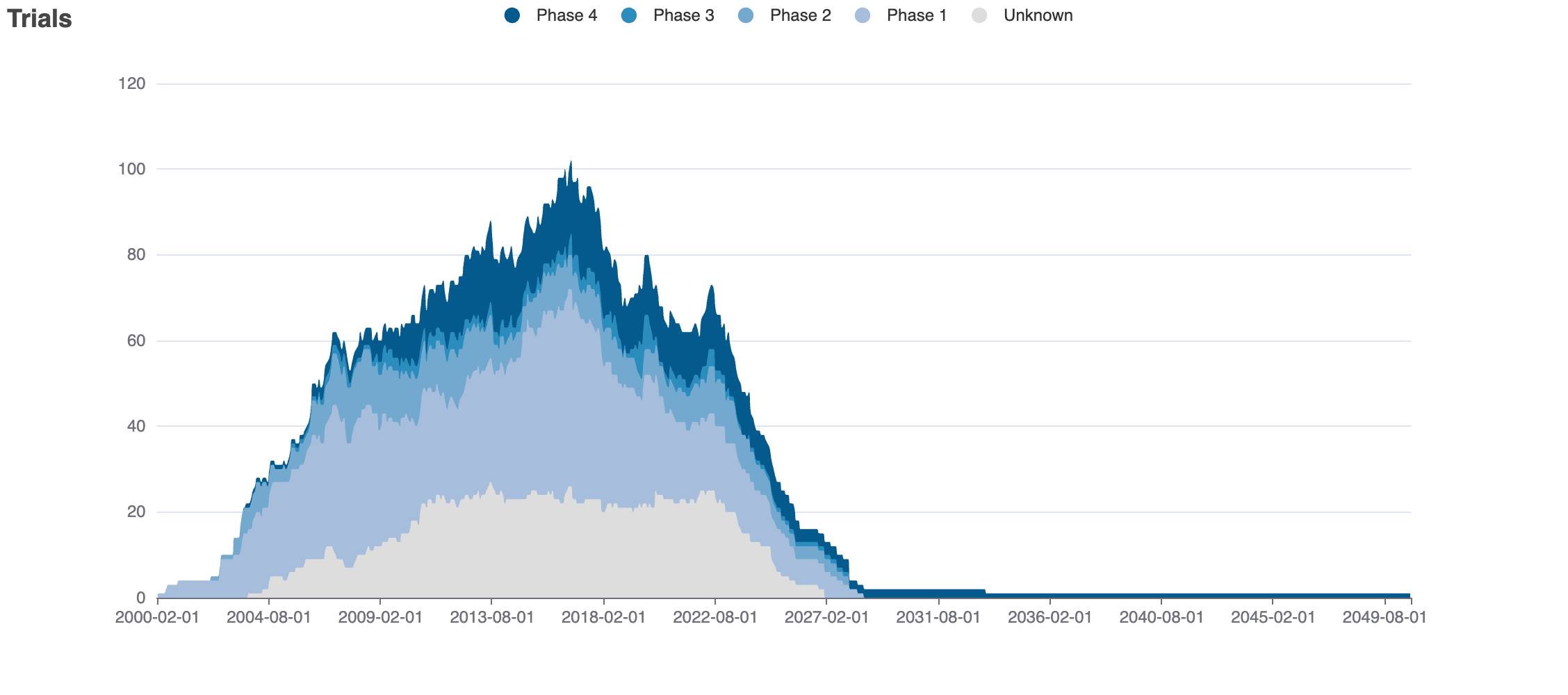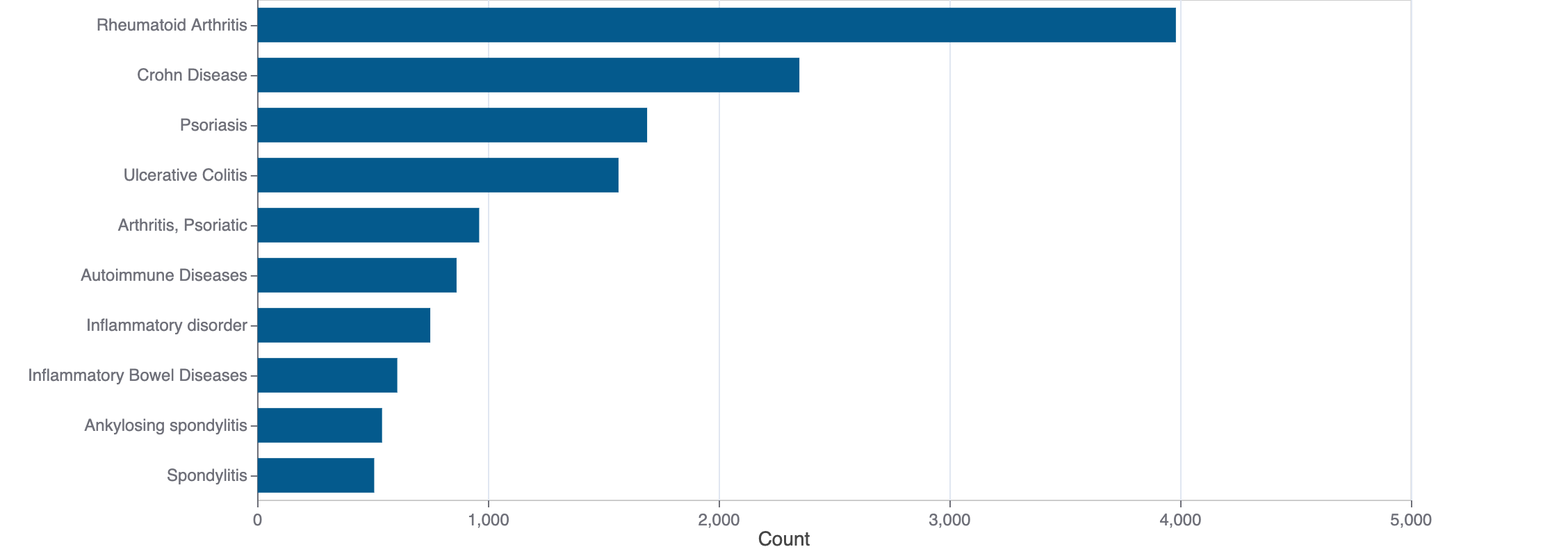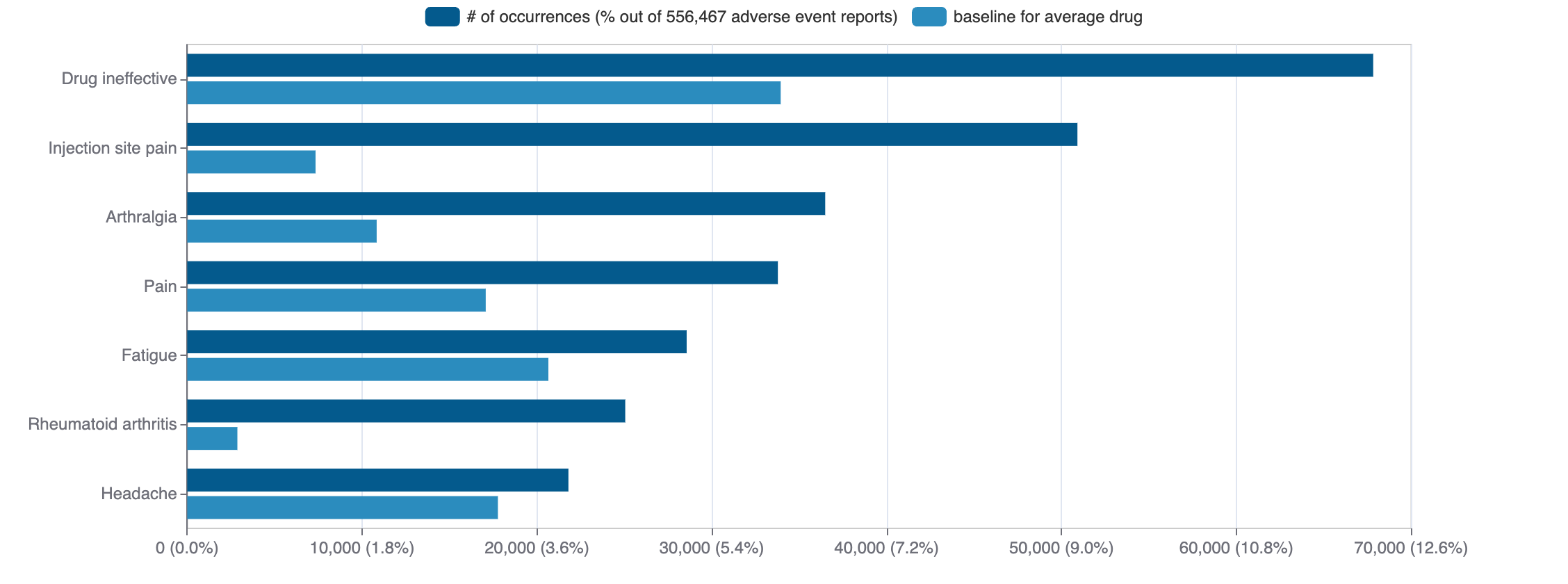Acetazolamide
Diamox (acetazolamide) is a small molecule pharmaceutical. Acetazolamide was first approved as Diamox on 1982-01-01. It is used to treat altitude sickness, glaucoma, and seizures in the USA. The pharmaceutical is active against carbonic anhydrase 7. In addition, it is known to target carbonic anhydrase 12, carbonic anhydrase 14, carbonic anhydrase 1, carbonic anhydrase 4, and carbonic anhydrase 13.
Download report
Favorite
Commercial
Trade Name
FDA
EMA
No data
Drug Products
FDA
EMA
New Drug Application (NDA)
New Drug Application (NDA)
Abbreviated New Drug Application (ANDA)
Abbreviated New Drug Application (ANDA)
Labels
FDA
EMA
Brand Name | Status | Last Update |
|---|---|---|
| acetazolamide | ANDA | 2023-05-19 |
Indications
FDA
EMA
Indication | Ontology | MeSH | ICD-10 |
|---|---|---|---|
| altitude sickness | EFO_1000782 | D000532 | T70.29 |
| glaucoma | EFO_0000516 | D005901 | H40 |
| seizures | HP_0007359 | D012640 | G40.4 |
Agency Specific
FDA
EMA
No data
Patent Expiration
No data
HCPCS
Code | Description |
|---|---|
| J1120 | Injection, acetazolamide sodium, up to 500 mg |
Clinical
Clinical Trials
129 clinical trials
View more details

Mock data
Subscribe for the real data
Subscribe for the real data
Indications Phases 4
Indication | MeSH | Ontology | ICD-10 | Ph 1 | Ph 2 | Ph 3 | Ph 4 | Other | Total |
|---|---|---|---|---|---|---|---|---|---|
| Altitude sickness | D000532 | EFO_1000782 | T70.29 | 4 | 1 | 3 | 12 | 2 | 21 |
| Chronic obstructive pulmonary disease | D029424 | EFO_0000341 | J44.9 | — | — | 3 | 9 | — | 12 |
| Obstructive sleep apnea | D020181 | EFO_0003918 | G47.33 | 2 | 5 | — | 4 | 1 | 10 |
| Heart failure | D006333 | EFO_0003144 | I50 | — | — | 2 | 4 | 1 | 7 |
| Sleep apnea syndromes | D012891 | EFO_0003877 | G47.3 | 1 | 3 | — | 2 | 2 | 7 |
| Pulmonary hypertension | D006976 | EFO_0001361 | I27.20 | — | 3 | 2 | 1 | — | 4 |
| Glaucoma | D005901 | EFO_0000516 | H40 | — | — | 1 | 2 | — | 3 |
| Alkalosis | D000471 | HP_0001948 | E87.3 | — | — | 1 | 1 | 1 | 3 |
| Pulmonary edema | D011654 | EFO_1001134 | J81 | — | — | — | 1 | 1 | 2 |
| Polycythemia | D011086 | EFO_0005804 | D75.1 | 1 | 1 | — | 1 | — | 2 |
Show 9 more
Indications Phases 3
Indication | MeSH | Ontology | ICD-10 | Ph 1 | Ph 2 | Ph 3 | Ph 4 | Other | Total |
|---|---|---|---|---|---|---|---|---|---|
| Pseudotumor cerebri | D011559 | EFO_1001132 | G93.2 | 1 | 1 | 3 | — | — | 4 |
| Stroke | D020521 | EFO_0000712 | I63.9 | — | 1 | 1 | — | 1 | 3 |
| Retinal artery occlusion | D015356 | EFO_1001154 | H34.1 | — | — | 1 | — | — | 1 |
| Hemodilution | D006438 | — | — | 1 | — | — | 1 | ||
| Visual acuity | D014792 | — | — | 1 | — | — | 1 | ||
| Fibrinolysis | D005342 | — | — | 1 | — | — | 1 | ||
| Neurocysticercosis | D020019 | — | 1 | 1 | — | — | 1 | ||
| Status epilepticus | D013226 | EFO_0008526 | G41 | — | 1 | 1 | — | — | 1 |
| Landau-kleffner syndrome | D018887 | EFO_1001010 | G40.8 | — | 1 | 1 | — | — | 1 |
| Obesity hypoventilation syndrome | D010845 | EFO_1001382 | E66.2 | — | — | 1 | — | — | 1 |
Indications Phases 2
Indication | MeSH | Ontology | ICD-10 | Ph 1 | Ph 2 | Ph 3 | Ph 4 | Other | Total |
|---|---|---|---|---|---|---|---|---|---|
| Macular edema | D008269 | — | 3 | — | — | — | 3 | ||
| Macular degeneration | D008268 | EFO_0001365 | H35.30 | — | 2 | — | — | — | 2 |
| Diabetic retinopathy | D003930 | EFO_0003770 | — | 2 | — | — | — | 2 | |
| Cerebrospinal fluid leak | D065634 | G96.0 | — | 2 | — | — | — | 2 | |
| Neoplasms | D009369 | C80 | 1 | 1 | — | — | — | 2 | |
| Chronic pain | D059350 | HP_0012532 | — | 1 | — | — | — | 1 | |
| Compliance | D003187 | — | 1 | — | — | — | 1 | ||
| Tachycardia | D013610 | HP_0001649 | R00.0 | 1 | 1 | — | — | — | 1 |
| Orthostatic intolerance | D054971 | 1 | 1 | — | — | — | 1 | ||
| Hypertension | D006973 | EFO_0000537 | I10 | — | 1 | — | — | — | 1 |
Show 7 more
Indications Phases 1
Indication | MeSH | Ontology | ICD-10 | Ph 1 | Ph 2 | Ph 3 | Ph 4 | Other | Total |
|---|---|---|---|---|---|---|---|---|---|
| Healthy volunteers/patients | — | 1 | — | — | — | — | 1 | ||
| Pure autonomic failure | D054970 | 1 | — | — | — | — | 1 | ||
| Orthostatic hypotension | D007024 | I95.1 | 1 | — | — | — | — | 1 | |
| Glioma | D005910 | EFO_0000520 | 1 | — | — | — | — | 1 | |
| Prostatic neoplasms | D011471 | C61 | 1 | — | — | — | — | 1 | |
| Cognition | D003071 | EFO_0003925 | 1 | — | — | — | — | 1 | |
| Small cell lung carcinoma | D055752 | 1 | — | — | — | — | 1 | ||
| Cocaine-related disorders | D019970 | F14 | 1 | — | — | — | — | 1 | |
| Pharmacokinetics | D010599 | 1 | — | — | — | — | 1 | ||
| Andersen syndrome | D050030 | 1 | — | — | — | — | 1 |
Show 1 more
Indications Without Phase
Indication | MeSH | Ontology | ICD-10 | Ph 1 | Ph 2 | Ph 3 | Ph 4 | Other | Total |
|---|---|---|---|---|---|---|---|---|---|
| Sickle cell anemia | D000755 | EFO_0000697 | D57 | — | — | — | — | 2 | 2 |
| Migraine disorders | D008881 | EFO_0003821 | G43 | — | — | — | — | 2 | 2 |
| Thalassemia | D013789 | EFO_1001996 | D56 | — | — | — | — | 1 | 1 |
| Brain edema | D001929 | EFO_1000845 | G93.6 | — | — | — | — | 1 | 1 |
| Kidney calculi | D007669 | EFO_0004253 | N20.0 | — | — | — | — | 1 | 1 |
| Bartter syndrome | D001477 | Orphanet_112 | E26.81 | — | — | — | — | 1 | 1 |
| Intracranial hypertension | D019586 | EFO_1000992 | — | — | — | — | 1 | 1 | |
| Angle-closure glaucoma | D015812 | — | — | — | — | 1 | 1 | ||
| Headache | D006261 | HP_0002315 | R51 | — | — | — | — | 1 | 1 |
| Ventilator weaning | D015300 | — | — | — | — | 1 | 1 |
Show 2 more
Epidemiology
Epidemiological information for investigational and approved indications
View more details
Drug
General
| Drug common name | ACETAZOLAMIDE |
| INN | acetazolamide |
| Description | Acetazolamide is a sulfonamide, a member of thiadiazoles and a monocarboxylic acid amide. It has a role as a diuretic, an anticonvulsant and an EC 4.2.1.1 (carbonic anhydrase) inhibitor. It is a conjugate acid of an acetazolamide(1-). It derives from a hydride of a 1,3,4-thiadiazole. |
| Classification | Small molecule |
| Drug class | carbonic anhydrase inhibitors |
| Image (chem structure or protein) | |
| Structure (InChI/SMILES or Protein Sequence) | CC(=O)Nc1nnc(S(N)(=O)=O)s1 |
Target
Alternate
CA12
CA12
CA14
CA14
CA1
CA1
CA4
CA4
CA13
CA13
Variants
Clinical Variant
No data
Financial
No data
Trends
PubMed Central
Top Terms for Disease or Syndrome:

Mock data
Subscribe for the real data
Subscribe for the real data
Additional graphs summarizing 13,857 documents
View more details
Safety
Black-box Warning
No Black-box warning
Adverse Events
Top Adverse Reactions

Mock data
Subscribe for the real data
Subscribe for the real data
14,032 adverse events reported
View more details
Premium feature
Learn more about premium features at pharmakb.com
Learn more
